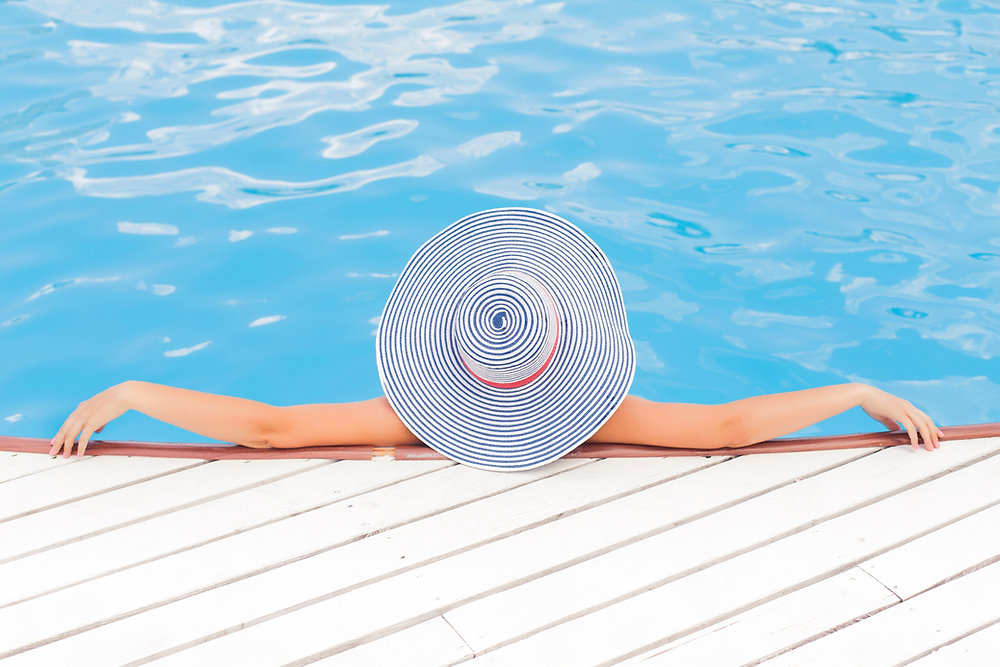What are the different types of swimming pool materials?
Most in-ground pools are either made from gunite, fiberglass, or vinyl. Between these three, there are endless options available to suit your landscaping, space, and design ideas.
1. In-Ground Concrete Swimming Pools
Gunite is a great choice when it comes to swimming pool material. Concrete pools are often called “gunite” pools... but you may have heard of "shotcrete" pools, too. Gunite and shotcrete are quite similar and pools can be constructed using either process.
The difference comes down to the concrete mixing with the water. Shotcrete always refers to wet concrete that's already fully mixed before it's shot out of a hose. Gunite, on the other hand, is a dry concrete mix that only mixes with water at the end of the nozzle just as it's being sprayed onto the pool surface. Gunite is definitely the more popular of the two versions.
Gunite swimming pools get built onsite. The excavation gets lined with a shell of reinforced steel, which has a mixture of cement and sand blasted into it through a high-pressure nozzle. The gunite cures and hardens to form the pool shell.This pool building process allows for enormous flexibility when it comes to shape and size.
Whether you want a classic pool shape or are leaning towards a freeform pool that looks more natural, a gunite pool can give you what you want. Straight line, curves, intricate details, or utter simplicity, you can pick a pool to suit your vision.
Visual Versatility and Appeal
Finishing off the interior of a gunite pool can be done in many ways. You can opt for glass tiles, which will lend an extra touch of color to the sparkle of your pool - deep turquoise, ocean azure, or any shade in between. River pebble aggregates offer natural charm. Or you can be spoilt for color choice with epoxy paint finishes.
Gunite Maintenance and Durability
Of the three pool material types, gunite needs the most care and maintenance. Regular brushing will prevent algae buildup and the surface might need etching with an acid wash. Gunite pool care will take more time than the other pool types.
But this regular care pays off as with proper maintenance, gunite pools can outlast the others for decades without need repairs or major overhauls. In most cases concrete pools will resurfacing every 8-10 years. However, concrete pools can be prone to cracks, especially if the ground is unstable.
2. In-Ground Vinyl Swimming Pools
A vinyl-lined pool is made from an in-ground steel, plastic, or reinforced concrete frame that has a heavy-duty vinyl liner attached to it. A vinyl pool is the least expensive type of pool to put in. They can be built to most shapes and sizes, but aren't quite as versatile as a gunite/concrete pool. Vinyl pools are quick to install and they will not crack from earthquakes or soil settlement.
Vinyl Versatility and Appeal
Vinyl liners come in a beautiful range of shades that will enhance the atmosphere you want to create in your outdoor area. Vinyl is not only available in different colors, but texture options too, including a mosaic or sand effect.
Vinyl Maintenance and Durability
Vinyl liners are the least durable of the three types of in-ground pools. They are vulnerable to tearing. On average, a liner will need replacing every five to ten years.
The thin material is easily damaged through kids' rough play, sharp tree branches, or animal claws or teeth. It's worth investing in a heavy-duty liner.
When it comes to pool maintenance, vinyl liner pools tend to accommodate algae growth. Sun creams and sunblock products often stain the liner around the edge at water level.
3. In-Ground Fiberglass Swimming Pools
A fiberglass pool is one of the most expensive to install but is a dream to maintain. Pool design is limited to what shapes are available as the pool is a one-piece, prefabricated shell. The design often incorporates seats, benches, or spas and cannot be wider than 16 feet.
Once the hole is dug, the pool shell will be lowered into it using a crane. Once in place, the opening around the edges is topped up with soil and the pool paving is laid. Fiberglass pools are the quickest to install.
Fiberglass Versatility and Appeal
Fiberglass pools are available in a variety of colors and patterns that visually mimic the texture of more intricate pool coatings without the rough texture.
Fiberglass pools are smooth to the touch and are extremely kid-friendly with no sharp edges that could scrape tender skin.
Fiberglass Maintenance and Durability
The smooth surface of a fiberglass pool resists the growth of algae and is super-easy to keep clean and looking good. You'll need fewer chemicals to maintain a fiberglass pool than the other types. Fiberglass outlives a vinyl-lined pool. You can expect your pool to last between 10 and 15 years.
With your pool design settled, contact us for recommendations on pool builders and our bespoke pool deck options to complete your exquisite new outdoor area.

